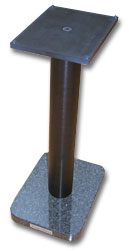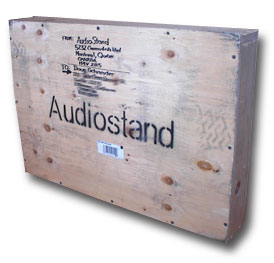![[SoundStage!]](../titles/sslogo3.gif) Home
Audio Home
Audio Equipment Review |
|||||||||||||||||
April 2000 Audiostand Loudspeaker Standsby Doug Schneider
I love small speakers. Perhaps it's because I can usually get great sound in a smaller listening room than I can with much larger, floorstanding speakers. However, there are disadvantages to small speakers. One of them is that you usually need to buy stands. There is, then, a hidden cost when purchasing small speakers. Another disadvantage can occur in the area of performance. With a floorstanding loudspeaker, the designer can ensure that, among other things, the speaker is at the right listening height and can do things to the bottom of the speaker to help ensure that it will have a stable footing. With small speakers, the designer is at the mercy of consumers and must hope that they use suitable stands. Some manufacturers that make bookshelf speakers offer stands, but this is rare. For the most part, you must go the third-party route and mix and match until you find the right stand. What’s interesting is that while the function of a speaker stand is rather simple -- lift the speaker off the floor -- the diversity of stand designs is astounding. I have four sets of stands in my listening room, including the Audiostand model reviewed here, and all of them are different. Two sets are made of metal, but differ substantially in shape and weight, while another is all MDF with a special internal "filling." The Audiostand model is made out of granite, metal and the Dupont-created Corian faux stone. Description The Audiostand company is located in Montreal, Canada, but it also has an office in the US. Audiostand makes stands for speakers and equipment racks too. The materials used and the design principles are similar for each type of product the company makes. The racks are priced starting at $2495, and the speaker stands are at $795 per pair. The company sells factory-direct. You can’t accuse Audiostand of taking the easy way out. The company has chosen to use materials that are not necessarily easy to work with or low in price (particularly in comparison to welded metal and MDF), but the goal was to make something that performs well and looks good. The result is a product line that will appeal to more well-heeled listeners. The base of the speaker stand uses 1.25" granite. The column of the stand is made from hollow aluminum, about three inches in diameter and finished in either silver or black. This column is hollow and can be filled with sand or lead shot. Audiostand filled the review samples with sand. The top plate is 1/2" Corian. Rubber bumpers are placed on this top plate to protect the speakers from scratches and give a little more isolation between speaker and stand. Spikes are supplied and screw into inserts on the bottom of the granite. The company also supplies little discs for the spikes in case the stands will be used on a floor that you are worried about scratching. In this case, simply slide the little disc so the spike sits atop it. Audiostand chose to use a tripod footing for the spikes (i.e., three contact points on the floor -- two in the front and one in the back center). This makes it much easier to get a firm placement and level the speaker. However, it offers slightly less stability than having four spikes, one in each corner. If you're using these and are worried about the speakers being bumped into, you may want to talk to the company about getting the stand made with four spikes instead of three.
Commensurate with the price, the stands come very well packed. They must be assembled by the user, so they are delivered in a crate that is relatively flat, but tall and wide. Because the stands are very expensive, Audiostand tries to avoid damage by using an all-wood crate. It’s heavier than cardboard, but much more durable. My stands arrived in perfect shape. The construction choices have inherent advantages -- and one disadvantage. First the advantages. The specific materials chosen give the stand a very heavy and non-resonant feel (particularly when the center column is filled). Most all-metal stands I’ve used have a "ring" that sometimes stays even when the stands are filled with sand or shot. Sometimes this resonance can harm the sound of the loudspeakers the stands support. The Audiostand stands are very dead, particularly when you rap on the top plate. Instead of a "ping, ping," you hear "thup, thup." In turn, this gives a firm and non-resonant footing that won’t hinder the performance of the speaker. In short, the speaker should be able to sing as it's intended to without moving or vibrating. When reading the Audiostand literature, I noted that this was one of the company's design goals. The choice of materials also looks good, particularly the aluminum and granite. While many are content with basic black metal stands that usually have a decidedly industrial look, others may want something more appealing that will compliment a room, not detract from it. People who don’t care what their stands look like will probably find that the Audiostand stands are a bit pricey. But for those who want some form with their function, these stands are a rare breed in the audiophile world -- they look good. Few companies target this market; pARTicular is one other company I can think of. Another advantage in this design comes as a result of having a center column that is removable and replaceable. Audiostand supplies these stands in 20", 24" and 28" heights. Should you sell your speakers and need a stand of a different height, you can just replace this column and not the entire stand. With welded metal stands, this is not normally possible. Should you need a custom height, that’s possible too. Now the disadvantage. In order to get these three materials together to form the stand, you must bolt it all together. I’ve found that any time a stand is bolted or screwed together, there is a chance that it will loosen up over time. As well, compared to a completely solid stand, meaning one that is bonded by either welding or glue, bolted stands tend not to be quite as rigid. In the case of these stands, Audiostand offers large bolts for the top and bottom along with corresponding Allen wrenches. You can crank down very hard on the Corian, but you must take care to get just the right tightness for the granite. The owner's manual explains the process well, and Audiostand supplies a nylon washer for use with the granite base. The base of the stands measure 9" wide by 12" deep, making it suitable for the majority of average-sized, stand-mounted speakers. For example, I used the stands with Merlin TSM-SE, Cliffhanger Audio CHS-2, and even the Paradigm Atom speakers. (The Atoms retail for only $179 per pair -- a fraction of the price of the stands!) There were a couple of exceptions, however. Cliffhanger Audio’s new Bulldog loudspeaker and the Speaker Art Clef series of loudspeakers are very large and heavy compared to most stand-mounted speakers. While the Audiostand stands will hold these just fine, the size of the base makes the combination potentially unstable should, say, someone bump into the speaker or stand. However, this doesn’t just apply to the Audiostand stands; it applies to any stand of similar size too. Use While some people like to talk about the sound of various speaker stands, I’m hesitant to do this. The first reason for this is obvious: Stands don’t really make any sound on their own (although I guess a resonant, ringing stand may excite the air to a degree, and this sound could be described). Instead, the stands can affect the sound of the speakers, so their performance is, more or less, indirect. So the whole area of making a definitive judgment on how a stand sounds with a speaker is fraught with difficulty. In fact, I don’t think it is even possible. Can you really predict how a stand will interact with every known speaker without knowing the size, construction and materials involved with the construction of the stand? If a stand resonates, is it going to resonate identically with each speaker on top of it? Of course not. The best you can do is describe the use and results of the product with the speakers you have. I used these stands in my reference system and to a lesser extent in my home-theater system. In the main system, I placed the stands on a carpet with hardwood flooring underneath. In the other system, I used the discs to protect the floor. In both cases the speakers had a sure footing. From lightweight to more substantial speakers, the Audiostands gave them all a solid, non-resonant footing from which to sing. Tapping on the stands or playing loud music that may excite certain frequencies produced no noticeable ringing or sound-damaging anomalies. In fact, this is one of the deader-sounding speaker stands I have here and is comparable in this regard with the now-discontinued, all-MDF, completely solid BBC stands that I often use with the best speakers I have on hand. Both of these stands exhibit a kind of deadness you associate with something like really hard rubber, yet they have a firmness that you get from the use of hard materials without the high-frequency ringing or vibrations. Conclusion Audiostand succeeds by mixing form with function and performance. While the stands certainly aren’t inexpensive, in terms of appearance they are head and shoulders above the black metal stands that dominate the market. Those who don’t find the appearance of stands as important can likely do better with low-cost, all-metal welded stands. Likewise, if you have low-cost speakers, the money would likely be better spent moving up to a better pair of speakers than to buy an extremely expensive stand like this one or some other. However, for those who want something a little more attractive and perhaps a little more versatile (in terms of the center column that can be replaced should you need a different height for a different speaker), give newcomer Audiostand a look and listen. ...Doug Schneider
|
|||||||||||||||||
|
|||||||||||||||||
![[SoundStage!]](../titles/sslogo3.gif) All
Contents All
ContentsCopyright © 2000 SoundStage! All Rights Reserved |

